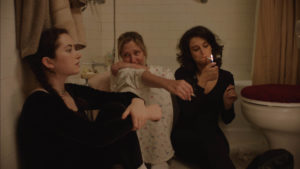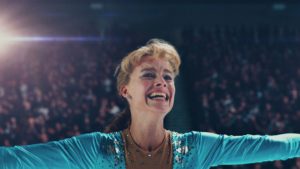
The Babadook is, at first glance, very similar to what I often call (with some degree of derision) a “classy horror film”. Obviously that’s not so much an official term as it is a grouping in my head, a way to organize an idea. There’s no real consistency in style, themes, or genre trappings, but they all have a central thing in common: “classy horror films” seem to be almost ashamed of actually being a horror film. I’m thinking here of something like Rosemary’s Baby. It’s not that it’s a bad film – although I very much dislike it – it’s that it seems to be uncomfortable with being a genre picture. It’s afraid to be lurid, to be pulpy, to be viscerally frightening. Whether it’s purposeful rejection or not, it’s indicative of the still alive prejudice against genre works by “serious” viewers, critics, and filmmakers. Serious people like serious movies, and they won’t be having this blood-drenched, vulgar, physical cinema, which means they won’t be having the kind of stuff that made me fall in love with horror films in the first place. It leaves a bad taste in my mouth when I see most classy horror films because I don’t want movies that strive to be respectable; respectable is boring. The audience deserves more, and the genre can be more.
Thank god then that The Babadook, for all its shiny polish and “serious art” connotations, is not afraid or ashamed to be scary. It’s not afraid to be jolting, to have real monsters, and to be alive. It rises above class and respectability by using the solid backbone of the genre film to tell a resonant and affecting tale while never losing sight of its trappings. The Babadook made me feel true dread and anxiety, which is rare after consuming so much of this stuff so regularly. In its masterful use of shadows, you feel that danger can come from anywhere in the decrepit, dying house that is the film’s main setting. There’s no safety, just the oppressive darkness constantly closing in around our two main characters. It’s a film that gets to have its cake and eat it too; yes, the central danger is a metaphor, one that represents depression, grief, and suffering, but it’s also a brilliantly realized combination of tropes and trappings put together in a way that manages to feel spectacularly new while drawing on a strong cultural history to help fill in the picture.
Amelia, a widow whose husband died in a car accident while driving her to the hospital, is a bundle of frayed and exposed nerves as she tries to take care of her young son, Samuel. Deeply impacted by his mother’s inability to move on from her husband’s death, Samuel crafts weapons and acts out often, fearful of monsters and desperately attached to his mother. His emotional problems cause him to be expelled from school, and through a series of incidents the family is isolated from everyone around them; work, friends, school, and family all fall away until they are truly alone with each other, without outlet or escape. While this is happening, they come across a pop-up book that describes a terrible monster, the Babadook, a man in a massive black coat and top hat with long arms, fangs, and grotesque bulging eyes who kills those he encounters. Soon enough, the two begin seeing the Babadook everywhere, threatening their home and lives.
There’s two obvious ways to take this premise. You could take the high-minded way, implying throughout that the Babadook is simply a figment of the family’s imagination conjured up by unbearable levels of stress, or you could take the low road, showing the Babadook as a real monster, an external force come to terrorize this family when they are at their weakest point. Neither of these are bad necessarily, but they’re also not inherently exceptional, and it’s to The Babadook‘s credit that it instead constantly finds ways to weave in and out of the two. The question of the Babadook’s reality is mostly unimportant; although there are plenty of scenes showing the mother’s increasing stress and decreasing grip on the outside world, there’s never any big “aha!” scene where it all comes together. Instead, the danger posed to this family by Amelia’s own actions complements and works with the danger posed to the family by the Babadook himself. You could turn the movie into a puzzle, but it doesn’t ever ask you to. Instead, it uses both psychological and physical horror to get its point across, never feeling the need to separate the two as if one will corrupt the other. They work in tandem throughout, creating a truly endangered and stressful space, full of fear and malevolence. The Babadook is a metaphor, of course, but it’s also very real, and the film trusts in itself enough to know that these two things are not contradictory.
[SPOILER WARNING: Skip the next two paragraphs to avoid spoilers for The Babadook]
In addition to the uncommonly frightening atmosphere this storytelling decisions create, The Babadook also uses these same techniques to exceptional emotional ends, and nowhere is this clearer than the end of the film. Again, there are two main endings that the genre would place upon this film. In one, the monster is vanquished and we return to normalcy (maybe with a mostly unimportant last jump scare as a stinger), while in the other the family is destroyed by the monster, unable to defeat it. The Babadook goes its own way, feinting one way or the other until the last reveal. In the end, we find a happy family, reunited and whole, but with a monster in the basement (literally) that they will continue to feed. Trapped behind a door covered in a mess of locks, the Babadook remains. The family’s life is healthier, but deeply changed by their experiences.
The monster, the Babadook, is depression and grief and sorrow; in a word, the Babadook is suffering, and you can’t ever get rid of that. Loss and sadness don’t magically dry up and leave your home, no matter how hard you fight them. They merely retreat, and the best outcome is learning to live with them haunting you. If Amelia and Samuel starved the Babadook, never feeding it those worms, it would burst out again, possibly taking them forever this time, and if they offered true food to it they would be swallowed up and die in its shadows. The Babadook does not shy away from this; to experience the pain that this family has gone through means knowing forever the danger you’re in. The Babadook was probably always in their house anyways; after all, someone must’ve given them the book in the first place. Now they at least know where he lives, and they know how to keep him appeased while still pushing most of the shadows out of their home. To survive and live after suffering requires this acknowledgement, and The Babadook leverages its upsetting of genre tropes to make this point. It’s not one way or the other, to vanquish or be vanquished; to live a real life, a full life, is to find a way to live with the things you can’t get rid of without them consuming you.
[END SPOILERS]
This precise and expert combination of visceral horror and emotional heft is what’s made The Babadook linger in my mind. It feels almost like it must’ve cheated somehow; how else do you combine the art house and the genre picture so successfully without them bouncing off each other in contrast? Jennifer Kent must be some sort of magician to get the whole thing to not only work but absolutely kill. Her craft is stunning and impeccable, recalling things as chronologically disparate as German Expressionism and the modern ghost movie and finding ways to meld it all together into a seamless whole. And all for her first feature film! There are times experiencing art where you can see something iconic being created. “Can’t miss” and “must see” are cliché phrases at this point, but if any horror film in 2014 is essential viewing, it’s this one.
—
Directed by Jennifer Kent; written by Jennifer Kent; starring Essie Davis, Noah Wiseman, Daniel Henshall and Tim Purcell; 93 minutes.
The Babadook is currently experiencing a limited theatrical release.



 Derek
Derek
 Isabelle
Isabelle